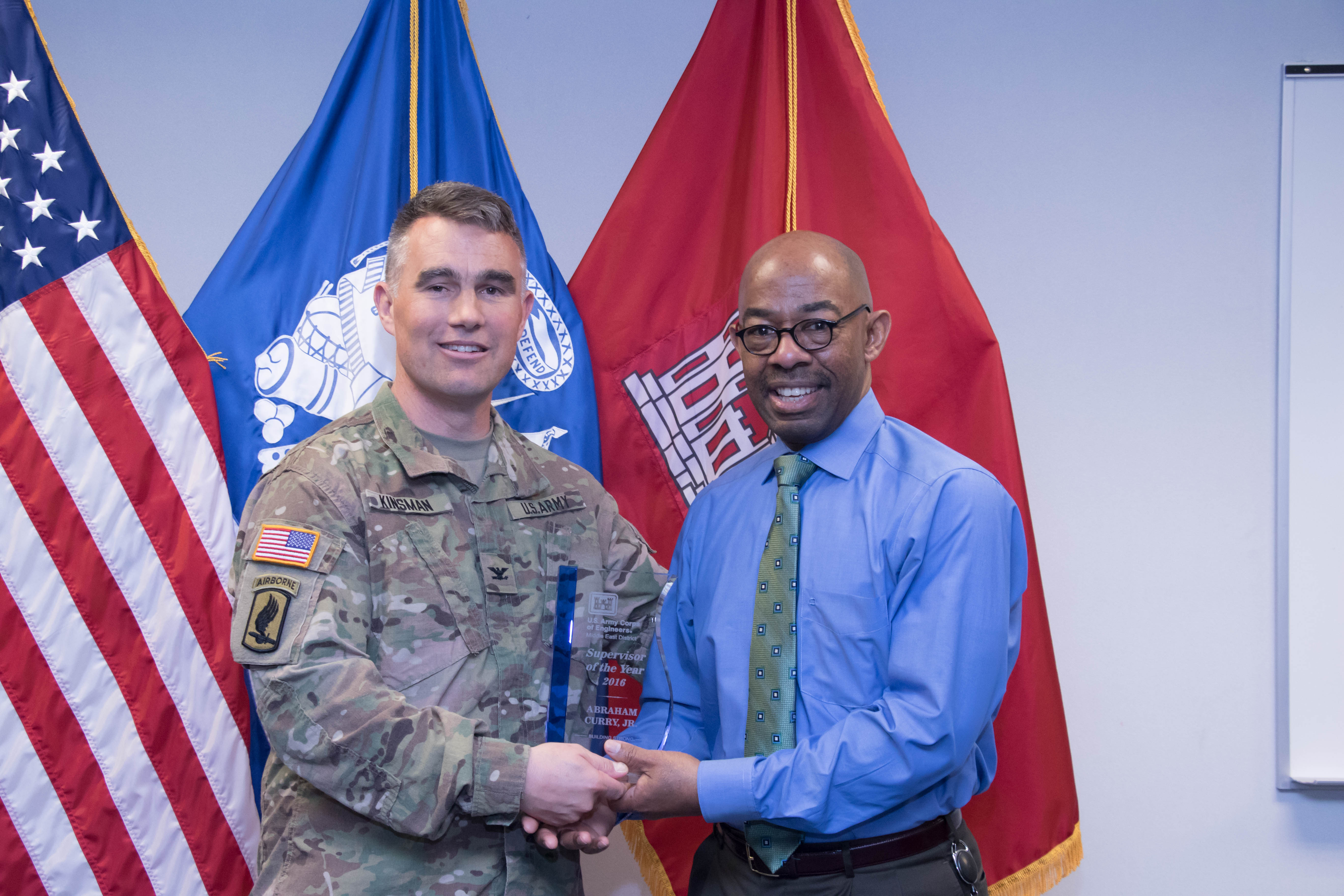
COMMAND/ORGANIZATION: Transatlantic Middle East District, U.S. Army Corps of Engineers
TITLE: Section chief and contracting officer
YEARS OF SERVICE IN WORKFORCE: 14
YEARS OF MILITARY SERVICE: 20
DAWIA CERTIFICATIONS: Level III in contracting
EDUCATION: M.S. in human resources, Central Michigan University; B.S. in human resources, Saint Leo University
AWARDS: Kansas City District Heartland Award; Certificate of Appreciation, Hurricane Katrina/Rita Support; Department of Army Certificate of Appreciation, Hurricane Katrina/Rita Support; Department of Army Achievement Medal for Civilian Service, Iraq; Commander’s Award for Civilian Service; NATO Non-Article 5 Medal for service in support of Balkans Operations
Army experiences pay off in civilian career
By Susan L. Follett
Now a section chief and contracting officer with the U.S. Army Corps of Engineers (USACE), Abraham Curry spent 20 years in the Army, retiring in March 2001 at the rank of master sergeant. The planning, communication and teamwork skills he developed in the Army are still important in the work he does for USACE.
Curry is with the Winchester, Virginia-based Transatlantic Middle East District, which consolidates engineering requirements and sets priorities for USACE operations throughout the Middle East and Central Asia. He was part of a team that received the 2016 Secretary of the Army Award for Specialized Services and Construction Contracting for work on the Mosul Dam. The two-mile-long dam—the largest in Iraq—is on the Tigris River, 31 miles north of Mosul, and creates a reservoir that’s eight miles long. The dam was built in 1985 on a foundation of soluble rock, which is continuously dissolving, resulting in the formation of cavities and underground voids. USACE led an effort to fill in the holes and maintain the dam’s structural integrity and operating capability.
“Our team consisted of members from sister USACE districts who played very important roles,” Curry said. “We also received support from our PARC (principal assistant responsible for contracting) office and USACE headquarters. There were a lot of late-night and weekend product delivery team meetings, but it was all for a very good cause. I cannot say enough good things about the team members. Without the assistance and support of every member of the project, the award would have not been possible.”

Col. Patrick V. Kinsman, left, commander of U.S. Army Corps of Engineers Middle East District, congratulates Abraham Curry after presenting him with the 2016 Supervisor of the Year Award. (U.S. Army photo by Shannon Hodges, USACE)
What you do in your position and why is it important to the Army or the warfighter?
I am one of two contracting section chiefs for my branch. My section provides pre- and post-award contracting support for a range of actions, including architect-engineer services, construction, simple acquisition purchases and large and small services contract actions. Most projects are either foreign military sales or foreign military financing, so we have diverse customers, stakeholders and project delivery team (PDT) members that we interact with daily. My greatest satisfaction is when the section and the PDT meet or exceed our customers’ expectations.
How did you become part of the Army Acquisition Workforce, and why?
I became a member through a DA internship. For me, it was a logical follow-on from working in logistics [while on active duty] in the Army.
What do you see as the most important points in your career with the Army Acquisition Workforce, and why?
While there are many important points in my acquisition career, the two that stand out are deploying for Hurricane Katrina support and being a PDT member for the Mosul Dam architect-engineering services contract. In both, I met and worked with some great people. Mosul Dam is in our area of responsibility, but civil projects are not something we work on with a lot of frequency. Because of this, our PDT included members from our sister districts, who provided technical support and advice that was instrumental in the successful award of the contract. When I deployed after Hurricane Katrina in 2005, I had just completed my internship, and the assignment gave me a chance to apply my newly acquired skills to help the people of Louisiana after a catastrophe. I discovered that I knew more than I thought, and, more importantly, the deployment was a chance to meet, work with and learn from people who had more contracting knowledge and experience than me.
Can you name a particular mentor or mentors who helped you in your career? How did they help you?
I have been fortunate to have worked with and for some truly great people during my career. At each step, from the Kansas District to the Europe District, and now the Middle East District, there was someone who was willing to take time from their day to mentor and guide me, and for that I will always be grateful to them.
“Faces of the Force” is an online series highlighting members of the Army Acquisition Workforce through the power of individual stories. Profiles are produced by the U.S. Army Acquisition Support Center Communication and Support Branch, working closely with public affairs officers to feature Soldiers and civilians serving in various AL&T disciplines. For more information, or to nominate someone, please contact 703-664-5635.
Subscribe to Army AL&T News, the premier online news source for the Acquisition, Logistics, and Technology (AL&T) Workforce.







